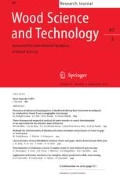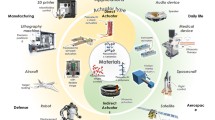Summary
The piezoelectric effect in wood, i.e. the occurrence of electric polarization under mechanical stress and also of mechanical strain in an electric field, was accounted for by considering the uniaxial orientation of cellulose crystallites in fibers and their monoclinic symmetry. A shear stress in one plane, including the grain direction, produced electrical polarization perpendicular to it. The value of the piezoelectric modulus for wood was approximately one twentieth of that of a quartz crystal.
The chemical treatments which transform the lattice structure from cellulose I to II or III, increased the piezoelectric modulus. However, gamma-ray irradiation up to a dose sufficiently high to decrease the molecular weight had only little influence on the piezoelectric modulus.
The variation with temperature of the phase angle between sinusoidal stress and polarization showed a maximum of advanced phase around room temperature and a maximum of delayed phase at about-100°C. Dielectric and viscoelastic measurements indicated that the former was caused by the dielectric loss due to water at a temperature above freezing and the latter by the viscoelastic loss due to local vibrations of cellulose molecules.
The piezoelectric polarization in wood can be utilized in technical problems such as the measurement of shock velocity in timber. The physiological meaning of the piezoelectrical effect in plants has not been investigated.
Zusammenfassung
Der piezoelektrische Effekt in Holz, d. h. das Auftreten einer elektrischen Polarisation unter mechanischer Spannung und ebenso das Auftreten mechanischer Verformungen in einem elektrischen Feld wird als Folgeerscheinung der einachsigen Orientierung der Cellulosekristallite in den Holzfasern und durch deren monokline Symmetrie erklärt. Es wurde beobachtet, daß eine Scherspannung in einer Ebene, welche in Faserrichtung liegt, eine elektrische Polarisation senkrecht dazu hervorruft. Die Größe des piezoelektrischen Moduls für Holz betrug etwa 1/20 des piezoelektrischen Moduls eines Quarzkristalls.
Chemische Behandlungen, welche die Gitterstruktur der Cellulose I in diejenige von Cellulose II und III umformen, erhöhen gleichzeitig den piezoelektrischen Modul. Dagegen zeigte eine Behandlung mit ψ-Strahlen selbst bis zu einer Dosisleistung, die ausreichte, um das Molekulargewicht zu erniedrigen, nur geringen Einfluß auf den piezoelektrischen Modul.
Die Temperaturabhängigkeit des Phasenwinkels zwischen einer S-förmig verlaufenden Spannung und der Polarisation zeigt ein Maximum der vorauseilenden Phase etwa bei Raumtemperatur und ein Maximum der nachlaufenden Phase bei etwa-100°C. Dielektrische und viskoelastische Messungen ließen erkennen, daß die Dielektrizität auf Grund dielektrischer Verluste von Wasser über 0°C zustande kommt und daß die Viskoelastizität durch viskoelastische Verluste auf Grund örtlicher Schwingungen von Cellulosemolekülen entsteht.
Die piezoelektrische Polarisation bei Holz kann für die Lösung technischer Probleme, wie z. B. bei der Messung der Schallgeschwindigkeit in Holz praktisch eingesetzt werden. Die physiologische Bedeutung des piezoelektrischen Effekts in lebenden Pflanzen ist bisher noch unbekannt.
Similar content being viewed by others
References
Bassett, C. A. L.: Electrical Effects in Bone. Scientific American Vol. 213 (1965) p. 18/25.
—, and R. O. Becker: Generation of Electric Potentials by Bone in Response to Mechanical Stress. Science Vol. 137 (1962) p. 1063/1064.
—, R. J. Pawluk, and R. O. Becker: Effects of Electric Currents on Bone in vivo. Nature Vol. 204 (1964) p. 652/654.
Bazhenov, V. A.: Piezoelectric Properties of Wood. New York 1961: Consultant Bureau.
Cady, W. G.: Piezoelectricity. 1946. Dover Pub.
Fukada, E.: Piezoelectricity of Wood. J. Phys. Soc. Japan Vol. 10 (1955) p. 149/154.
Fukada, E.: Piezoelectric Effect in Wood and Other Crystalline Polymers. Proceedings of Second Symposium on Nondestructive Testing of Wood. Washington State Univ. 1965, p. 143/172.
—, M. Date, and N. Hirai: Piezoelectric Effect in Poly-μ-methyl-L-glutamate. Nature Vol. 211 (1966) p. 1079.
— and K. Hara: Temperature Variation of Complex Piezoelectric Modulus of Wood. Reports on Progress in Polymer Physics in Japan Vol. 10 (1967) p. 403/406.
— and T. Emura: Piezoelectric Effect in Cellulose Acetate. Reports on Progress in Polymer Physics in Japan Vol. 10 (1967) p. 407/410.
—, and I. Yasuda: On the Piezoelectric Effect of Bone. J. Phys. Soc. Japan Vol. 12 (1957) p. 1158/1162.
—: Piezoelectric Effects in Collagen. Japan. J. Appl. Phys. Vol. 3 (1964) p. 117/121.
Galligan, W. L., and L. D. Bertholf: Piezoelectric Effect in Wood. Forest Prod. J. Vol. 12 (1963) p. 517/524.
Galligan, W. L., and R. W. Courteau: Measurement of Elasticity of Lumber with Longitudinal Stress Waves and the Piezoelectric Effect of Wood. Proceedings of Second Symposium on Nondestructive Testing of Wood, Washington State Univ. 1965, p. 223/244.
Shamos, M. H., L. S. Lavine, and M. I. Shamos: Piezoelectric Effect in Bone. Nature Vol. 197 (1963) p. 81.
—: Piezoelectricity as a Fundamental Property of Biological Tissues. Nature Vol. 213 (1967) p. 267/269.
Author information
Authors and Affiliations
Rights and permissions
About this article
Cite this article
Fukada, E. Piezoelectricity as a fundamental property of wood. Wood Science and Technology 2, 299–307 (1968). https://doi.org/10.1007/BF00350276
Received:
Issue Date:
DOI: https://doi.org/10.1007/BF00350276




